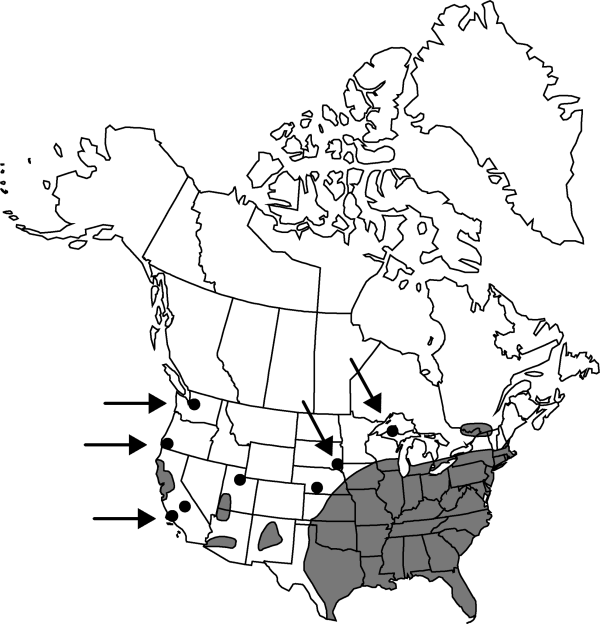Difference between revisions of "Dysphania ambrosioides"
Ukrayins’k. Bot. Zhurn., n. s. 59: 382. 2002.
FNA>Volume Importer |
FNA>Volume Importer |
||
| Line 15: | Line 15: | ||
|name=Chenopodium ambrosioides var. suffruticosum | |name=Chenopodium ambrosioides var. suffruticosum | ||
|authority=(Willdenow) Ascherson & Graebner | |authority=(Willdenow) Ascherson & Graebner | ||
| − | }}{{Treatment/ID/Synonym | + | }} {{Treatment/ID/Synonym |
|name=Teloxys ambrosioides | |name=Teloxys ambrosioides | ||
|authority=unknown | |authority=unknown | ||
| Line 33: | Line 33: | ||
|elevation=0-700 m | |elevation=0-700 m | ||
|distribution=Ont.;Que.;Ala.;Ariz.;Ark.;Calif.;Conn.;Del.;D.C.;Fla.;Ga.;Ill.;Ind.;Iowa;Kans.;Ky.;La.;Maine;Md.;Mass.;Mich.;Miss.;Mo.;Nebr.;N.H.;N.J.;N.Mex.;N.Y.;N.C.;Ohio;Okla.;Oreg.;Pa.;R.I.;S.C.;S.Dak.;Tenn.;Tex.;Utah;Vt.;Va.;Wash.;W.Va.;Wis.;native to North America and South America;widely naturalized throughout the tropics and warm-temperate regions of the world. | |distribution=Ont.;Que.;Ala.;Ariz.;Ark.;Calif.;Conn.;Del.;D.C.;Fla.;Ga.;Ill.;Ind.;Iowa;Kans.;Ky.;La.;Maine;Md.;Mass.;Mich.;Miss.;Mo.;Nebr.;N.H.;N.J.;N.Mex.;N.Y.;N.C.;Ohio;Okla.;Oreg.;Pa.;R.I.;S.C.;S.Dak.;Tenn.;Tex.;Utah;Vt.;Va.;Wash.;W.Va.;Wis.;native to North America and South America;widely naturalized throughout the tropics and warm-temperate regions of the world. | ||
| − | |discussion=<p>Southern populations of Dysphania ambrosioides are native while those populations in the northern part of the flora area are introduced.</p> | + | |discussion=<p>Southern populations of <i>Dysphania ambrosioides</i> are native while those populations in the northern part of the flora area are introduced.</p> |
|tables= | |tables= | ||
|references= | |references= | ||
| Line 57: | Line 57: | ||
|publication year=2002 | |publication year=2002 | ||
|special status= | |special status= | ||
| − | |source xml=https://jpend@bitbucket.org/aafc-mbb/fna-data-curation.git/src/ | + | |source xml=https://jpend@bitbucket.org/aafc-mbb/fna-data-curation.git/src/8f726806613d60c220dc4493de13607dd3150896/coarse_grained_fna_xml/V4/V4_490.xml |
|genus=Dysphania | |genus=Dysphania | ||
|section=Dysphania sect. Adenois | |section=Dysphania sect. Adenois | ||
Revision as of 17:28, 18 September 2019
Plants annual. Stems erect to ascending, much-branched, 3–10(–15) dm, ± glandular-pubescent. Leaves aromatic, distal leaves sessile; petiole to 18 mm; blade ovate to oblong-lanceolate or lanceolate, proximal ones mostly lanceolate, 2–8(–12) × 0.5–4(–5.5) cm, base cuneate, margins entire, dentate, or laciniate, apex obtuse to attenuate, copiously gland-dotted (rarely glabrous). Inflorescences lateral spikes, 3–7 cm; glomerules globose, 1.5–2.3 mm diam.; bracts leaflike, lanceolate, oblanceolate, spatulate, or linear, 0.3–2.5 cm, apex obtuse, acute, or attenuate. Flowers: perianth segments 4–5, connate for ca. 1/2 their length, distinct portion ovate, rounded abaxially, 0.7–1 mm, apex obtuse, glandular-pubescent, covering seed at maturity; stamens 4–5; stigmas 3. Achenes ovoid; pericarp nonadherent, rugose to smooth. Seeds horizontal or vertical, reddish brown, ovoid, 0.6–1 × 0.4–0.5 mm; seed coat rugose to smooth.
Phenology: Fruiting summer–fall.
Habitat: River bottoms, dry lake beds, flower beds, waste areas
Elevation: 0-700 m
Distribution

Ont., Que., Ala., Ariz., Ark., Calif., Conn., Del., D.C., Fla., Ga., Ill., Ind., Iowa, Kans., Ky., La., Maine, Md., Mass., Mich., Miss., Mo., Nebr., N.H., N.J., N.Mex., N.Y., N.C., Ohio, Okla., Oreg., Pa., R.I., S.C., S.Dak., Tenn., Tex., Utah, Vt., Va., Wash., W.Va., Wis., native to North America and South America, widely naturalized throughout the tropics and warm-temperate regions of the world.
Discussion
Southern populations of Dysphania ambrosioides are native while those populations in the northern part of the flora area are introduced.
Selected References
None.